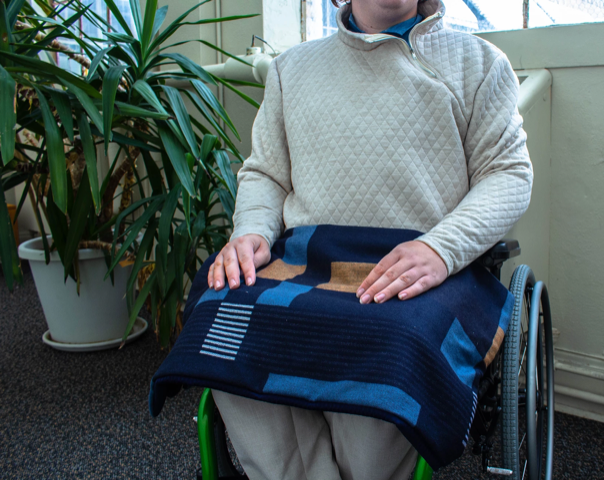Iowa State course creates clothing for those with disabilities
Morgan Tweed, graduate architecture student, in one of the outfits designed for him by the apparel, merchandising and design 426 class.
December 7, 2019
An Iowa State class is trying to spread awareness about clothing lines for people with disabilities.
Ellen McKinney, associate professor in apparel, events and hospitality management, teaches the apparel, merchandising and design 426 class.
“[The course is an] exploration of the creative process and sources of inspiration with emphasis on wearable art, experimentation of advanced design, problem solving, alternative materials, fabric manipulation and pattern-making techniques,” McKinney said.
A couple years ago there was an educational opportunity for Iowa State faculty. The faculty were to come up with their own way of teaching diversity and implementing it in the classroom. McKinney added the “Design for All” aspect to her class.
McKinney said she got her inspiration for this project from an Iowa State alum who had an internship with Target. While the student was interning for Target, they were starting to roll out their “Design for All” line.
“That’s where that kind of started and then I was also in this program at the same time and it all just came together,” McKinney said. “This would be a great opportunity to teach our students something about diversity [and] inclusion and how they can use their skills to help people.”
McKinney said some big-name clothing brands, including Tommy Hilfiger, Target, Kohl’s and Zappos, have been implementing disability-catered apparel into their company in the last couple of years.
While some students chose to work with someone they already knew, the class also gets in touch with the Student Accessibility Services on campus. McKinney reaches out to their office and the office reaches out to students to recruit them for the class project.
After the Student Accessibility Services office gets names of individuals who would like to participate, McKinney gets in contact with them and asks them to send in a short bio of what their style is and what kind of activities they are involved in as well as how their disability affects them.
All of the clients then come to class and have a panel presentation, and afterward the students pick which client they would like to work with.
“Sometimes the students will have a familiarity with a certain disability from their friends or family, so then they choose that person,” McKinney said.
After the students get to know their clients better through an interview session about their wants and needs, they take measurements and start sketching. McKinney said the client meets up with the students again to go over sketches and pick out what they are going to make.
In a later class period, they make a sample garment and the client comes in to try it on. They will let the students know what is working and what is not working.
Once they know for sure everything fits and functions how it’s supposed to, they work on the final garment. After a photoshoot of the client wearing the final garment, everyone presents their clothing in class.
Finally, the students can enter their garment into The Fashion Show.
Morgan Tweed, graduate architecture student, modeled his outfit at The Fashion Show 2019. Tweed was diagnosed with stiff person syndrome, which put him in a wheelchair. Tweed said one of his ideals he was looking for in clothing was comfort.
“Most clothes are not designed for wheelchair use,” Tweed said. “They’re not designed to be sitting all day.”
The group of students designing the clothes for Tweed made a pair of business slacks with a magnetic closure. They also made a shirt to mimic a button up, but it was also made with magnetic snaps.
Selena Pintor, senior in apparel, merchandising and design, took McKinney’s apparel, merchandising and design 426 class in 2017. Pintor’s group worked on sensibility issues.
“We made a vest that was weighted to soothe the client we were working with […],” Pintor said. “She had sensibility issues with her clothing so we made sure nothing on the inside would bother her, the seams or the ties or anything like that.”
Pintor said it is very important to think about adaptable clothing and people don’t realize how privileged they are to not have to think about the shopping experience the way others might have to.
“Design for All” is one of three projects in the course. McKinney said one of the other projects has been wearable technology and the third is something that uses art as inspiration. For more information on this course, visit the Iowa State course catalog.







